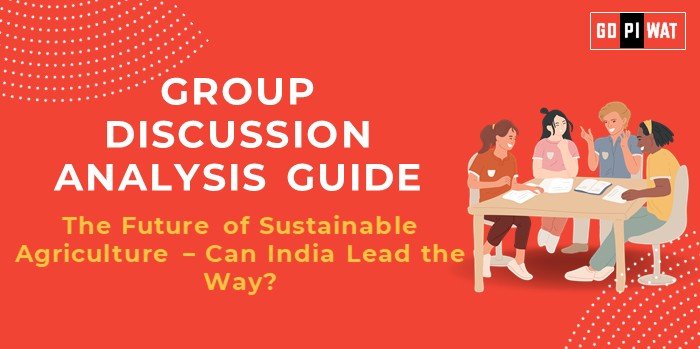📋 Group Discussion Analysis Guide: The Future of Sustainable Agriculture – Can India Lead the Way?
🌐 Introduction
Sustainable agriculture has become critical as nations address food security and environmental challenges. With its extensive agricultural base and commitment to innovation, India holds immense potential to lead in sustainable farming practices. However, challenges such as land fragmentation, resource depletion, and climate change test this ambition.
📊 Quick Facts & Key Statistics
- 🌾 Agriculture’s Contribution to GDP: 16% – Highlights its economic significance in India’s economy.
- 🌍 Carbon Emissions from Agriculture: 15% – Underlines the sector’s environmental impact, necessitating sustainable solutions.
- 🌱 Organic Farming Area: 1.7 million hectares – Demonstrates India’s progress in sustainable farming.
- 🍚 Food Grain Production (2018-19): 285 million metric tons – Reflects the sector’s crucial role in ensuring food security.
👥 Stakeholders and Their Roles
- 🏛️ Government: Implements policies promoting sustainable practices, such as soil health cards and micro-irrigation schemes.
- 👨🌾 Farmers: Adoption of organic methods, precision farming, and climate-smart practices.
- 🏢 Private Sector: Develops agri-tech tools like AI-based crop monitoring and soil analysis.
- 🌐 Global Organizations: Support funding and knowledge-sharing initiatives (e.g., FAO, UNDP).
📈 Achievements and Challenges
🌟 Achievements:
- ✅ Organic Farming Growth: 1.7 million hectares under cultivation.
- ✅ Sustainability Programs: Government initiatives like the National Mission on Sustainable Agriculture.
- ✅ Precision Agriculture: Growing adoption of data-driven techniques.
⚠️ Challenges:
- ⚠️ Land Degradation: Nearly 30% of India’s arable land is degraded.
- ⚠️ Small Landholdings: 86% of farmers have holdings under two hectares.
- ⚠️ Climate Variability: Frequent droughts and erratic rainfall.
🌍 Global Comparisons
- 🇳🇱 Netherlands: Leader in high-tech, sustainable farming.
- 🇮🇱 Israel: Efficient water management for agriculture in arid regions.
📋 Case Study:
Sikkim: World’s first fully organic state, showcasing scalable models for sustainability.
💡 Effective Discussion Approaches
- 📈 Opening Techniques:
- Highlight: “India produces 285 million metric tons of food grains, yet faces challenges like 30% land degradation.”
- Question: “Can India replicate success stories like Sikkim at a national scale to lead globally?”
- 🤝 Counter-Argument Handling:
- “While small landholdings pose challenges, farmer cooperatives can facilitate access to resources and technology.”
🔍 Strategic Analysis of Strengths & Weaknesses
SWOT Analysis:
- Strengths: Agricultural diversity, government focus on sustainability.
- Weaknesses: Infrastructure gaps, over-dependence on monsoons.
- Opportunities: Growth in agri-tech, international collaboration.
- Threats: Climate change, resource depletion.
🗣️ Structured Arguments for Discussion
- Supporting Stance: “India’s rich agricultural resources and innovations position it as a global leader in sustainability.”
- Opposing Stance: “Challenges like small landholdings and climate risks hinder India’s ability to lead effectively.”
- Balanced Perspective: “India’s progress in sustainable agriculture is commendable, but scaling efforts and overcoming systemic challenges remain vital.”
📚 Connecting with B-School Applications
- 📈 Real-World Applications: Sustainable agriculture aligns with supply chain optimization and resource management projects.
- ❓ Sample Questions:
- “How can India leverage technology to enhance sustainable farming practices?”
- “What lessons can India learn from global leaders in agriculture?”
- 🌟 Insights for Students:
- Agri-tech startups are creating impactful business opportunities.
- Sustainability in agriculture offers avenues for global partnerships and innovations.


